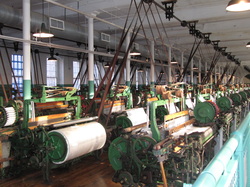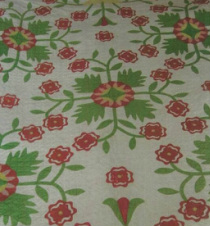
The Boott Mill weaving room
Saturday, November 19, 2011
Okay, I admit it. I played hooky today. I went in to the museum this morning. I got together all the books for the President's exhibition. I spent some time in the gallery thinking about placement of the quilts. I talked to Kate about labels and found she thinks Exhibit Labels by Serrell is the "Bible" as far as labels are concerned. She also had a couple more books that touch on labels and agreed to lend them to me.
Today is past the middle of November. It's warm and sunny -- 55 degrees. I haven't taken the time to go over to Boott Mill yet, so I'm going this afternoon. I am only going to be here a few more weeks. There are still more places I want to go. Boott Mill is one of them.
Boott Mill is one of the mills that operated here in Lowell. It began with four buildings on the canal, and expanded to larger buildings. Additional buildings were added to accommodate steam power later in the 19th Century. In the mill there are still looms and many of them were running today. Fascinating! Now I could finally see just how that process works -- I watched the shuttle run between the two edges of the loom and hit the "end" and get instantly shot back to the other side. In a split second, the frame holding the warp yarns shifts, then the shuttle returns. Back and fourth, back and fourth with incredible speed. Today there were still machinists, weavers and others minding the machines. The noise was deafening and the floors vibrated. I can't imagine what it must have been like to have all the machines running at once. No wonder hearing loss was common.
Upstairs was a museum. Old carding, weaving, drafting, etc. machines were up there so you could get close. There was also a short film about industry in America and the role the New England mills played in the industrial revolution. Included in the exhibit were a number of video stations where interviews of retired mill workers were played. They echoed what I have read over and over again. The work was hard and dangerous. The mills were a way of life. Yet these former mill workers all had a certain pride about the cloth that they produced. They didn't get rich in the mills, but they could survive.
Then I went over the the Boarding House, also part of the National Park Service. Really, these girls had pretty darn good living conditions, albeit their working conditions were horrid. They also ate very well. In the boarding house was a "keeper" -- a woman who cooked for them and raised them at 4 a.m. to get to the mill and work before breakfast. They then returned to the mill until lunch and had dinner late -- seven or eight o'clock, whatever time they finished working for the day. These women put in 12 hour days five days a week, plus 10 hours or so on Saturdays. Add it up! That's a 70-hour work week. No kidding! Then on Sundays they were required to be in church; company rules. If they didn't follow the rules, there were plenty of other girls that would gladly take their jobs.
It would be quite a study to learn about the sociological impact of mill life. The first laborers in the Lowell mills were young women from their family's farms. For them, working in the mills was their first experience in independence. They got paid -- although they often didn't actually get the money (it was sent home), they learned what 'earning power' was. How did this influence women's lives and their generation as a whole? Did the "Mill Girls" newly found independence change women's attitudes that contributed to the evolution of their status in the 19th and early 20th centuries? The women's movement began in the mid-19th Century. How much did labor rights play into it?
Okay, I admit it. I played hooky today. I went in to the museum this morning. I got together all the books for the President's exhibition. I spent some time in the gallery thinking about placement of the quilts. I talked to Kate about labels and found she thinks Exhibit Labels by Serrell is the "Bible" as far as labels are concerned. She also had a couple more books that touch on labels and agreed to lend them to me.
Today is past the middle of November. It's warm and sunny -- 55 degrees. I haven't taken the time to go over to Boott Mill yet, so I'm going this afternoon. I am only going to be here a few more weeks. There are still more places I want to go. Boott Mill is one of them.
Boott Mill is one of the mills that operated here in Lowell. It began with four buildings on the canal, and expanded to larger buildings. Additional buildings were added to accommodate steam power later in the 19th Century. In the mill there are still looms and many of them were running today. Fascinating! Now I could finally see just how that process works -- I watched the shuttle run between the two edges of the loom and hit the "end" and get instantly shot back to the other side. In a split second, the frame holding the warp yarns shifts, then the shuttle returns. Back and fourth, back and fourth with incredible speed. Today there were still machinists, weavers and others minding the machines. The noise was deafening and the floors vibrated. I can't imagine what it must have been like to have all the machines running at once. No wonder hearing loss was common.
Upstairs was a museum. Old carding, weaving, drafting, etc. machines were up there so you could get close. There was also a short film about industry in America and the role the New England mills played in the industrial revolution. Included in the exhibit were a number of video stations where interviews of retired mill workers were played. They echoed what I have read over and over again. The work was hard and dangerous. The mills were a way of life. Yet these former mill workers all had a certain pride about the cloth that they produced. They didn't get rich in the mills, but they could survive.
Then I went over the the Boarding House, also part of the National Park Service. Really, these girls had pretty darn good living conditions, albeit their working conditions were horrid. They also ate very well. In the boarding house was a "keeper" -- a woman who cooked for them and raised them at 4 a.m. to get to the mill and work before breakfast. They then returned to the mill until lunch and had dinner late -- seven or eight o'clock, whatever time they finished working for the day. These women put in 12 hour days five days a week, plus 10 hours or so on Saturdays. Add it up! That's a 70-hour work week. No kidding! Then on Sundays they were required to be in church; company rules. If they didn't follow the rules, there were plenty of other girls that would gladly take their jobs.
It would be quite a study to learn about the sociological impact of mill life. The first laborers in the Lowell mills were young women from their family's farms. For them, working in the mills was their first experience in independence. They got paid -- although they often didn't actually get the money (it was sent home), they learned what 'earning power' was. How did this influence women's lives and their generation as a whole? Did the "Mill Girls" newly found independence change women's attitudes that contributed to the evolution of their status in the 19th and early 20th centuries? The women's movement began in the mid-19th Century. How much did labor rights play into it?

Friday, November 18, 2011
Today I continued on reading about political quilts, handkerchiefs, etc. I also spent some time with Maureen, teaching her a few things in Photoshop so she will be able to create images for the new website. She may at times need to post the NEQM logo on the site with no background. She hasn't done that before, so I showed her how to create a .png file. We also decided for sure to use the splash page. I set it up and inserted some images although they aren't the ones we will be using. In fact, they're pretty bad. But they provide a visual so you can see what the program can do. And THAT was the day! Gees they go by quickly sometimes!
Today I continued on reading about political quilts, handkerchiefs, etc. I also spent some time with Maureen, teaching her a few things in Photoshop so she will be able to create images for the new website. She may at times need to post the NEQM logo on the site with no background. She hasn't done that before, so I showed her how to create a .png file. We also decided for sure to use the splash page. I set it up and inserted some images although they aren't the ones we will be using. In fact, they're pretty bad. But they provide a visual so you can see what the program can do. And THAT was the day! Gees they go by quickly sometimes!

Harrison Rose Variation
Thursday, November 17, 2011
My baby girl turned 21 today! Happy Birthday Miss Mozelle!
Today was dedicated to the President's exhibition. I'm reading through all the information we have received with each quilt from the owners. When the loan agreements were sent out, they were accompanied by a questionnaire. The loan agreements that have come back in have completed questionnaires. Some of them have several pages of additional information. At this point, Pam still is not sure whether she will be able to get some of the quilts she wants. She only came on board with the museum in July and has quickly put together this exhibition. Because of the short time, she still has some quilts that have not been secured. When I arrived in October, we sat down and went through all the quilts she was trying to get for the show. Surely by now we should know which ones are in and which ones are out. So, I am a little frustrated that I don't know exactly what will be in the exhibition.
I am trying to get my arms around a theme for the catalog and labels. In Serrell's label book, she calls this the "big idea." One of the thoughts I have is to categorize the quilts -- many are made with commemorative handkerchiefs, some use commemorative fabrics, some are pictorial, some have satirical themes. What am I going to hang together? What am I going to focus on in the labels beyond the obvious basic information about each one?
Pam printed off some labels the other day from the "Potholder Exhibition" she curated here last winter. She wanted me to see the format. She had taken a piece of paper and essentially cut it half with minimal information on the left side, and more detailed information on the right. She says there are two types of visitors -- those that want the 'quick and dirty' and those who will take the time to read in depth. I don't know about that, but I will say the labels from her show are awful. The information may be there, but they look like hell and there is no focus. I won't say they're unreadable. I will say they don't engage or invite readers. They are messy. Your eyes have no where to land. The two sides of the label compete with each other.
The NEQM inserts their labels into clear plexiglass and hung on the wall. The plexiglass is made to hold 81/2 x 11 paper labels. Because their budget is so tight, the possibility of posting labels of another size, or using another method is probably not an option. So, I will have to figure out a way to write the labels in this side-by-side pattern that Pam wants and make them easier to read.
My baby girl turned 21 today! Happy Birthday Miss Mozelle!
Today was dedicated to the President's exhibition. I'm reading through all the information we have received with each quilt from the owners. When the loan agreements were sent out, they were accompanied by a questionnaire. The loan agreements that have come back in have completed questionnaires. Some of them have several pages of additional information. At this point, Pam still is not sure whether she will be able to get some of the quilts she wants. She only came on board with the museum in July and has quickly put together this exhibition. Because of the short time, she still has some quilts that have not been secured. When I arrived in October, we sat down and went through all the quilts she was trying to get for the show. Surely by now we should know which ones are in and which ones are out. So, I am a little frustrated that I don't know exactly what will be in the exhibition.
I am trying to get my arms around a theme for the catalog and labels. In Serrell's label book, she calls this the "big idea." One of the thoughts I have is to categorize the quilts -- many are made with commemorative handkerchiefs, some use commemorative fabrics, some are pictorial, some have satirical themes. What am I going to hang together? What am I going to focus on in the labels beyond the obvious basic information about each one?
Pam printed off some labels the other day from the "Potholder Exhibition" she curated here last winter. She wanted me to see the format. She had taken a piece of paper and essentially cut it half with minimal information on the left side, and more detailed information on the right. She says there are two types of visitors -- those that want the 'quick and dirty' and those who will take the time to read in depth. I don't know about that, but I will say the labels from her show are awful. The information may be there, but they look like hell and there is no focus. I won't say they're unreadable. I will say they don't engage or invite readers. They are messy. Your eyes have no where to land. The two sides of the label compete with each other.
The NEQM inserts their labels into clear plexiglass and hung on the wall. The plexiglass is made to hold 81/2 x 11 paper labels. Because their budget is so tight, the possibility of posting labels of another size, or using another method is probably not an option. So, I will have to figure out a way to write the labels in this side-by-side pattern that Pam wants and make them easier to read.


 RSS Feed
RSS Feed